Gate Wars Starship Class Designations
Rather than divide this into 5 daily blog posts each covering 2-3 ships, I opted to give you the whole Gate Wars starship classification guide at once, a full week of content in one post.
What is Gate Wars? Well, nothing, at the moment. This is an example of what I sometimes do as a leisure-time activity – imagine a set of parameters, then write down a bunch of detailed worldbuilding specifications for one aspect of a setting matching those parameters. These are my text equivalents of doodles, or warm-up sketches, designed to amuse me and perhaps get the creative juices flowing, rather than build towards a goal.
In this case, I envisioned a science fiction setting where FTL travel was originally accomplished through Gate Stations – massive stationary locations where a Hyperspace gate could be built and starships “thrown” through it on one-way FTL trips – and then later mobile “Free” Gates were developed. Free Gates are built into starships and allow them (with a few hours of charging, assuming the Gate was kept “hot,” and a few weeks of charging if it wasn’t) to make FTL jumps on their own. Free Gates aren’t nearly as fast as Gate station trips, but they also aren’t one-way. A Free Gate can take you anywhere, but due to gravitational forces, some locations take much less energy to travel to, and allow you to go to them much fast. Known as Gate Fords, these are common routes for commerce, and thus popular targets for pirates (as opposed to Gate Stations, which are heavily armed and armored).
The following are ship categorizations as I have envisioned them over roughly a decade of doodling with this idea. Each gives the common name of a ship class, followed by its size class and common 2- or 3-letter designation. Ships of the same class are roughly the same size, though they can serve very different purposes. I foresaw sensors being able to detect a ship’s size class well before they could pick out any other details. Size class “A” exists because ships of that size are recent, and the old “largest mobile ships” were size class “1”, so the new designation was created for “bigger than Class 1” ships.
The tech details here are pretty minimal, with weapons largely just described (from most powerful to least) as spinal mounts, Primaries, missile tubes (which have significant drawbacks as being slower, subject to defensive fire, and running out of ammo in long deployments), Secondaries, and defensive guns.
(All at by Luca Oleastri)
Battleship [Size Class A] (BS)
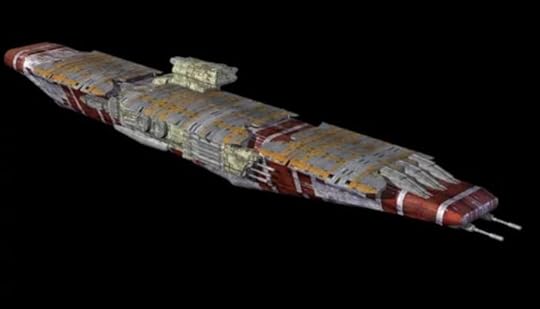
A battleship is the largest warship in any fleet, focused on heavy arms and armament. Battleships can generate their own Gates, and though they aren’t designed to bring additional ships through those Gates the sheer mass of a battleship allows a few Size Class 4 and smaller ships to tuck in tight and fly through in the time it takes the battleship to transition. Battleships are a relatively new development in star fleets, as it is only in the past 50 years a mobile Gate capable of transporting such massive vessel has been developed, and the resulting arms race to create ships able to take on stationary fortifications bankrupted some star nations. At the same time, when fleets with battleships have clashed with fleets of similar tonnage and tech level lacking a BS-class, the strategic need for battleships has been proven again and again.
The key role of battleships is to project force capable of taking out planetary installations, Gate Stations, and major starbases, while surviving the massive attacks such installations can unleash. In fleet maneuvers, battleships are the front-and-center core of offensive formations, anchoring entire fleets and being flanked, supported, and escorted by as many lesser ships as can be spared from other duties. Battleships almost always have a spinal mount weapon, and may have more than one (often with 2 or three facing forward, and 1 or two facing to the aft). It additionally carries multiple batteries of Primaries, with Secondaries or missile tubes emplaced only where space and power allow but a primary could not be made to work. Defensive guns tend to be clustered in tight batteries that give their best coverage to the front arc. Each space navy has its own exact preferred mix of weapons, but any battleship can outgun any smaller ships of any fleet.
A battleship also carries massive armor, powerful shield generators and backup screens, and vast banks of electronic warfare and countermeasure systems, but when a choice must be made between offense and defense, a battleship’s first concern is having more firepower than any other mobile unit. As a battleship is extremely likely to be the flagship of any fleet it is in, they do carry multiple command and control loops and tactical and strategic centers to allow for the operation of the ship by its captain, its fleet by an admiral, and an entire warfront by a war council, and enough diplomatic space to be able to host allies or accept enemy surrenders.
Unsurprisingly battleships are extremely expensive to build, and much more expensive per ton to maintain and operate, than less focused ships. Their narrow focus on the heavy armament needed for system sieges and major fleet engagements makes them no more effective for any other roles than a typical cruiser. Most mid-tier star navies have at most one battleship, often in mothballs, and even top-tier navies rarely have more than 8 total battleships, and no more than 2-3 active at once outside of wartime. Lower-tier star navies simply cannot afford to have modern battleships (though see pocket battleship), and no nongovernmental group can maintain and operate so expensive a vessel.
Fleet Carrier [Size Class A] (FC)
Fleet carriers are the largest warship to regularly see operations outside of wartime, and are on-par with battleships in terms of total tonnage. Rather than spinal mount spinal weapons or Primaries, fleet carriers give up their vast tonnage to carrying squadrons of smaller craft, focusing on non-FTL capable vessels the carrier takes from system to system, though any well-designer carrier also has a number of long-range scout ships, minelayers, recovery and repair craft, missile tenders, and troop transports. Carriers mount some Secondaries, and as many defensive batteries as they can cram onto the surface, but beyond the firepower of their squadrons, most of the punch of a carrier comes from missile batteries backed by their enormous and extremely advanced tracking and targeting sensors and computers.
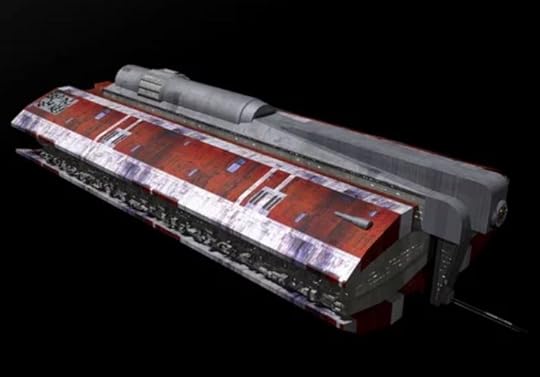
A fleet carrier is too valuable and too vulnerable to ever operate on its own, with the smallest unit to see a carrier being the single carrier group, which normally includes a single carrier, at least one combat vessel (preferably two dreadnaughts, but often just one dreadnaught and a heavy cruiser, two battlecruiers, or even two heavy cruisers), at least two escort ship (often a light cruiser or escort cruiser), one depot ship or tender, and three destroyers (or, if a fleet’s budget and resources are stretched too thin, one destroyer and two pinnaces or cutters). A carrier group is an extremely effective small fleet to deal with a broad range of issues, and can excel at patrol, scouting, escort, antipiracy, system defense, and diplomatic missions where the need to project force in an area needs to be combined with a less militaristic tone than sending a battleship or pocket battleship. Even a carrier group with a dreadnaught is often seen as less threatening than a dreadnaught group by itself, as the need to protect carriers is well-understood, as is the vast flexibility of carriers.
The biggest vulnerability of carriers is that they lack the massive armor and shielding of other warships in their size class, focusing on using their mass on defensive batteries and facilities to store, launch, recover, repair, and support smaller craft. A carrier caught without cover, preferably from both a few squads of active fightercraft and one or more escort ships, is vulnerable to much smaller warships including cruisers, destroyers, and in some cases even frigates.
Dreadnaught [Size Class 1] (DN)
A dreadnaught is a warship much larger than a cruiser, but not as massive as a carrier or battleship. Dreadnaughts have considerable firepower in the form of a single spinal mount weapon or dozens of Primaries (but not both), extremely heavy armor, and densely-packed defensive batteries. Numerous redundant systems, suites of damage control and repair operations, and more internal bracing and bulkheads per ton than any other ship class make dreadnoughts the toughest ships in any fleet, and while they lack the massive anti-planetary-installation power of a battleship, they can actually soak more damage than those larger warships.
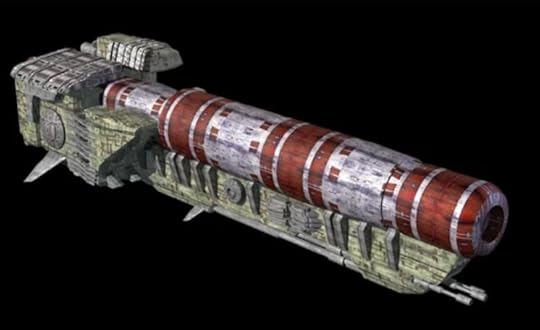
Dreadnaughts primarily serve as the anchor for small fleets not expecting to face space stations or battleships, mobile strongpoints to protect battleships and carriers, and as flagships for space navies unable to afford to build or maintain a battleship (or those so massive as to need numerous flagships and preferring to keep the majority of their battleships mothballed). While dreadnaughts are much more expensive than cruisers, their high durability can make them attractive choices for flagships in situations where the level of risk is not well known. Dreadnaughts often form the core of a carrier’s escort fleet, placing itself between a carrier and the direct line from an enemy fleet. Dreadnaughts can operate independently if needed, but are slower than cruisers and no more effective in nonmilitary matters, and actively worse as pursuit craft.
Missilenaught [Size Class 1] (MN)
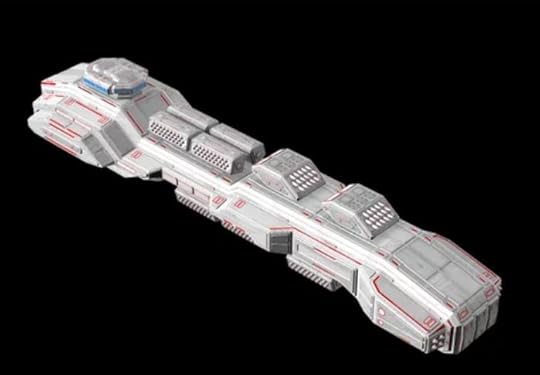
Before the creation of stable mobile Gates able to carrier massive Size Class A ships, the only proven method for taking out major starbases and planetary defenses was to swamp their defenses with a combination of asteroids accelerated by war tug craft and massive missile barrages. The job of carrying and launching those missiles, and surviving counterfire from a station, fell to “missilenaughts,” though very few fleets use that term for their own ships. Rather than focus on a spinal mount, Primaries, or even Secondaries, missilenaughts have as many missile lanchers as they can cram into their outer hull, and as many reloads as they can fit in interior space. This gives them a horrifically powerful throw-weight of offense… briefly. A single missilenaught lacks the firepower to take out a major station by itself, but before size class A ships existed, a section of 4 or 6misssilenaughts was the most efficient way to take out a single enemy base. However, missilenaughts are more fragile than standard dreadnaughts, and must be resupplied after each major engagement. Indeed, a missilenaught often runs out of missiles during a single long engagement, and no one builds them anymore. However, they remain a respectable threat, in some cases have become popular planetary defense ships or carrier escorts, and poorer governments sometimes buy old missilenaughts from richer fleets that no longer need them, representing a “cheap” way to have a Class 1 ship.
Pocket Battleship [Size class 1] (BP)
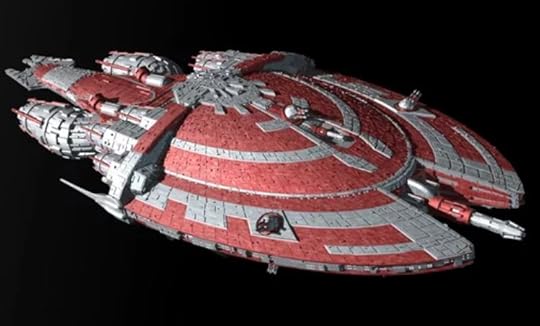
Also often termed pseudo-battleships, battle projectors, and siege vessels, a pocket battleship is an uncommon form of dreadnought designed to fill the battleship role, but on a smaller (and thus less effective) scale. Pocket battleships almost always have twin forward-facing spinal mount weapons, to allow effective firepower to be brought to bear against smaller space stations and planetary installations, and extensive Secondaries and defensive batteries. They pay for this heavy front-facing offense by lacking Primaries and being much less heavily armored than a typical dreadnought—often no more durable than a battlecruiser—and lacking the ability to engage in long-term independent operations. Pocket battleships are mostly only found in the fleets of older mid-tier star navies, or as a single flagship in a lower-tier star navy (though a small number of first-tier star navies do use pocket battleships in large fleet formations, such as an escort to a carrier or backup to a dreadnaught formation). While they are not cost-effective for anything other than assaulting light planetary defenses, having a ship able to project fleet-level offensive power and be more than a match for any cruiser is worth the expense for some star nations that simply lack the means to maintain true battleships, and those that need more offense in their ships of the wall than dreadnoughts provide.
Squadron Carrier [Size Class 1] (SC)
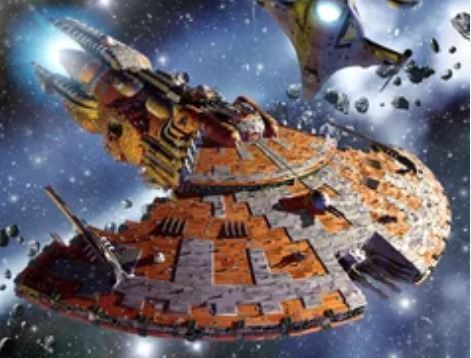
Also called secondary carriers and heavy escort carriers, most squadron carriers are conversions of older missilenaught (or, less often, pocket battleship) hulls built long enough ago that their offensive technologies are out of date and requiring massive overhaul anyway. In many cases, the cost of refitting such ships to match modern DN specifications is prohibitive, but converting them into smaller carriers is relatively cheap (especially compared to the cost of building new, full-size carriers). Although gutting such hulls to install Gate generators able to transport dozens of smaller craft with the main ship inevitably weakens them against heavy enemy fire, carrier tactics don’t call for surviving direct heavy fire. A small number of lower-tier star navies built squadron carriers as new constructions after Gate technology advanced to allow multivessel Gate travel, simply because they could not afford to build Size Class A carriers.
Super-Heavy Frigate [Size Class 1](XF)
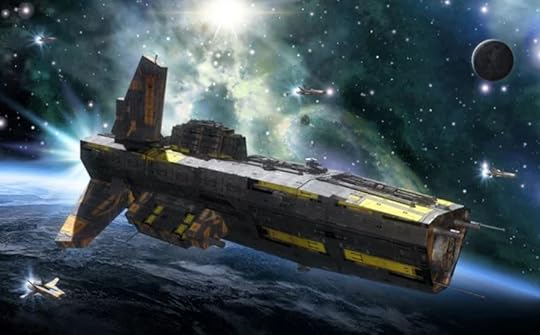
No fleet ever designed and constructed a super-heavy frigate from scratch, but the idea of a ship with the vast endurance and flexibility of a frigate, but on an even larger scale, did appeal to some star navies, especially as Free Gates proliferated and impacted strategic warfare and it became more common for ships to find themselves cut off from supply lines, or stranded when their home bases were destroyed or occupied. A few experimental craft of this type were created by converting other ships, including two famously adapted from capital ships (a dreadnaught and a carrier) that were so badly damaged they had to be refit from the keel-outward. While super-heavy frigates acquitted themselves well, ultimately they were determined to be too expensive to be practical in wartime, and too heavily armed to be needed in peacetime.
Battlecruiser [Size Class 2] (CB)
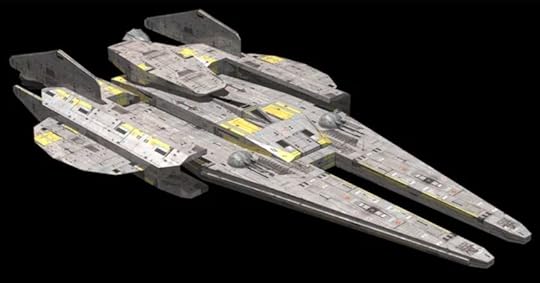
Battlecruisers are built on heavy cruiser frames, but focus on armor and more heavy and defensive weapons, and less on labs and diplomatic facilities. They are often considered “overgunned,” in that the more weapons you cram into their frames, the harder it is so have good armor and sensor coverage. Even so, no pirate wants to see a battlecruiser on their scopes.
Bulk Carrier/Q-ship [Size Class 2] (CB)
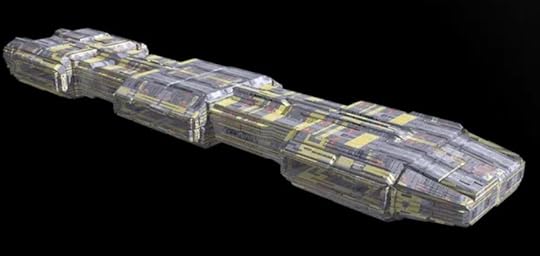
Massive cargo carriers with Free Gates that allow them to take millions of tons of cargo anywhere in the known systems. The risks of interstellar commerce means bulk carriers are always trying to save as much money as possible, so they are commonly traveling from Gate Ford to Gate Ford wherever possible to save on energy costs and generally only travel when full. This makes them appealing targets for pirates, if they pirates can either take out any defensive ships at a Gate Ford (or which there are too many for star fleets to guard *all* of them), especially if it’s a Gate Ford the bulk carrier thinks is a secret. Most civilian spaceship travel occurs in passenger sections of bulk carriers, with accommodations ranging from ships that have a few luxury decks on par with modern cruise ships, to paying for a spot in an empty crew bunk.
Although absolutely not designed for warfare, a bulk carrier can be retrofitted with internal armor bulkheads, massive banks of secondary screens, nearly as many missiles as a missilenaught, lots of defensive weapons, and a few Secondaries. This makes them “eggs with canons,” able to punch in the weight class of a battle cruiser (albeit wth less range), but more fragile than even a light cruiser. However, such ships (called “Q-Ships”) are sometimes used to hunt pirates, as they can retain their nonmilitary freighter appearance.
Smaller cargo ships also exist, of course, but economic realities generally makes them either non-Gate capable single-system shipping, or more like smugglers or special curriers than normal commerce vessels.
Command Cruiser [Size Class 2] (CC)
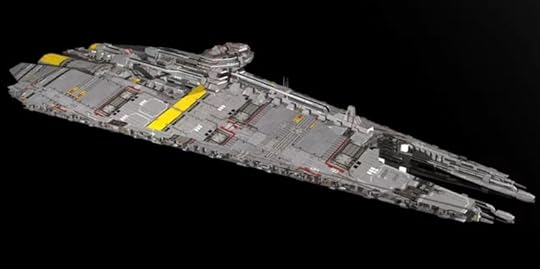
A command cruiser is essentially a heavy cruiser with the most modern sensors and labs possible, extra space added for a commodore or rear admiral to run a small fleet or a wing of a larger fleet, and diplomatic quarters. On paper they aren’t more effective in combat than heavy cruisers, but a combination of getting elite crews and being able to handle more unexpected situations often gives them an unexpected edge. They are a great deal more expensive per ton to build (though not to maintain), and low-tier fleets often don’t bother with them, or have one or two as flagships.
Destroyer Tender [Size Class 2] (DT)
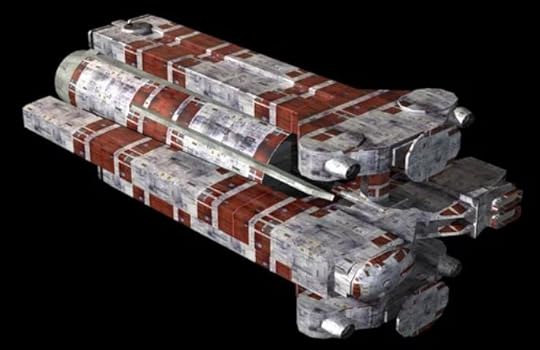
A destroyer tender is a noncombat ship designed specifically to provide support to a group of 3-7 destroyers. The tender has extensive resupply and cargo capacity, and the necessary parts, machine shops, and facilities to maintain a destroyer for long periods of time. While ideally a destroyer tender is custom-built to fulfill this role, in reality, tenders converted from bulk cargo haulers, mobile mining platforms, and salvage ships are far more common. Multiple destroyer tenders could also function as tender for a larger fleet.
Heavy Cruiser [Size Class 2] (CA)
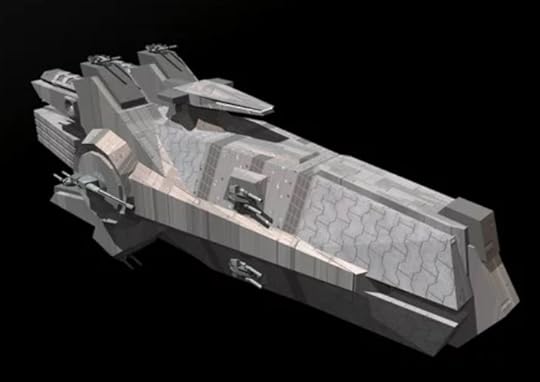
The workhorse of most star navies, the heavy cruiser is the modern incarnation of the pre-Free-Gate Armored Cruiser, which was designed to survive being sent through a system Gate and finding hostiles at the other end of its travel. Most mount a mix of a small number of Primaries, Secondaries, missiles, defensive weapons, sensors, interior carrier craft, labs, medical facilities, and diplomatic facilities, but they do not specialize in any of those roles. A heavy cruiser is designed to be a generalist, sacrificing being the best ship for any role by being an adequate ship for every roll.
Heavy Frigate [Size Class 2] (HF)
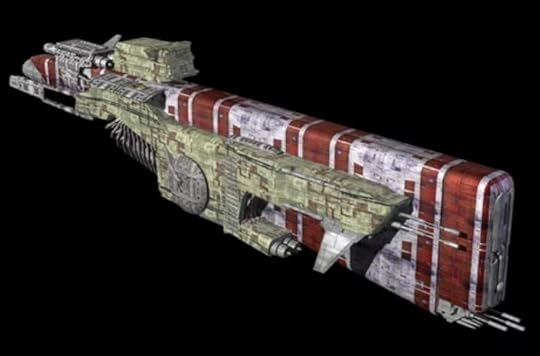
Heavy frigates were designed to be the next generation of free Gate ships, able to explore, scout, sit on-station, and even build and support an entire new colony from scratch. The size of later battle cruisers, heavy frigates had at-best a light cruiser’s armament, combined with extensive support systems and cargo capacity matched only by deep-space explorers or small stationary starbases. The improvement in free Gates, and the increasing number of shipyards able to build them, made the heavy frigate obsolete for its main function shortly after the first units became active, and most fleets have stopped building them.
The one combat advantage of a heavy frigate was its ability to survive damage – though no more armored than a true battle cruiser, a heavy frigate’s extensive secondary systems were generally built in a shell around its crucial components. While losing machine shops, vehicle hangers, cargo bays, conference rooms, theaters, and redundant secondary and tertiary systems reduced a heavy frigate’s flexibility and endurance, it didn’t reduce its overall combat effectiveness. Nothing smaller than a dreadnaught could survive as much damage as a heavy frigate.
Monitor [Size Class 2] (BM)
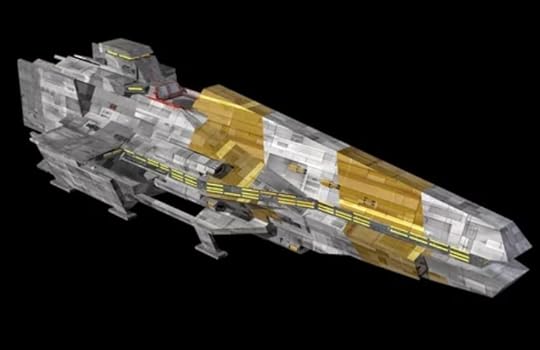
Monitors were originally constructed as system defense ships; heavily armed and armored vessels that lacked any significant noncombat functionality and had extremely limited operational endurance. While some ships of that type still exist, the main “monitor” of the modern era is a ship that combines the offense of a battlecruiser, and extended facilities of a command cruiser, and has greater armor than either, in exchange for not having a free Gate. They are only common in areas with a Gate Station, and fleets that can afford to build ships they never plan to deploy beyond those systems. A few Monitors can be found in orbit around old Gate Fords, having been sent to some battle by a Gate Station in desperate times, and having no way to go home. Generally still resupplied by their home fleets, they become de factor minor mobile stations at those Gate Fords.
Armored Frigate [Size Class 3] (AF)
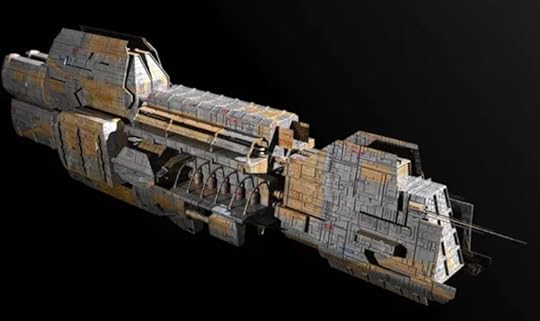
When old Free Gate ships were upgraded with modern engines and gate systems, they often ended up being able to haul much larger mass loads. While rebuilding their interior systems to add new weapons or secure cargo storage was too time-consuming to be practical, it was often possible to simply weld additional armor plates on over key points on the ship. The amount of benefit gained from this armor upgrade varied by design, but armored frigates gained a reputation for being able to absorb damage well out of proportion to their size.
Light Command Cruiser [Size Class 3] (CLC)
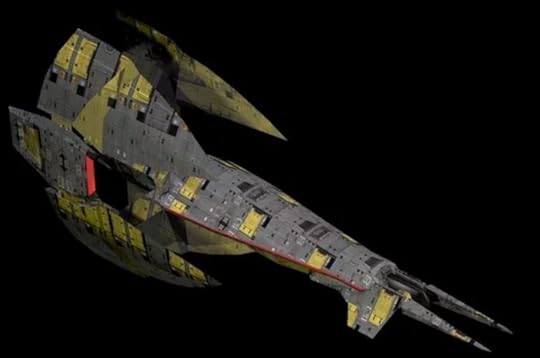
A light cruiser that sacrifices some breadth of utility for additional sensors, communication, and command facilities. Mostly only used by low-tier fleets who cannot afford command cruisers or bigger ships, often as flotilla leaders.
Light Cruiser [Size Class 3] (CL)
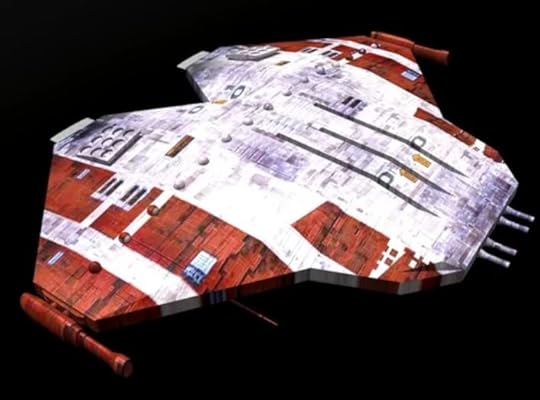
A heavy cruiser’s concept, but one size smaller. Rather than being “adequate” for any task, it’s adequate for common roles, and “better than nothing” for anything else. However, light cruisers are a good deal cheaper that heavy cruisers to build and maintain, and many fleets prefer having 5 light cruisers over 3 heavy cruisers.
Escort Cruiser [Size Class 3] (EC)
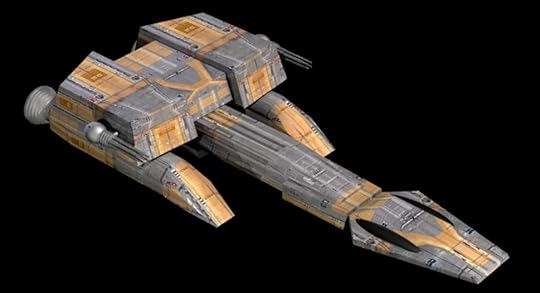
An escort cruiser is an uncommon class of ship designed exclusively to act as an escort for larger, more powerful starships such as carriers, dreadnaughts, and battleships. Most star navies lack the resources to have a class of dedicated cruisers this size, depending on destroyers, frigates, and even brigantines for such roles. Escort cruisers generally have no Primaries and only a small number of Secondaries, but are well-armed with defensive batteries covering all arcs, as well as extensive sensor arrays. Escort cruisers also have far more noncombat resources, and are designed to be able to pair with a larger ship to allow it to operate without a full support fleet, though normally anything important enough to have an escort cruiser assigned to it is important enough to have at least a few more smaller ships as well.
Escort Carrier [Size Class 3] (CE)
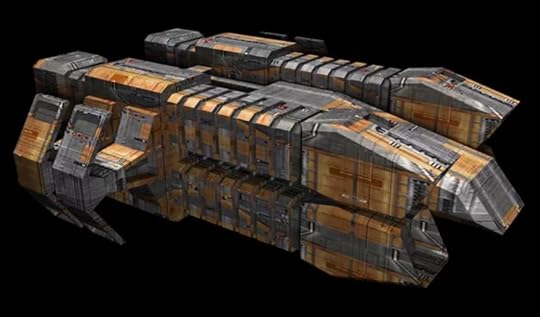
Escort carriers exist primarily to shuttle new fighters and supplies to larger carriers, though they can also serve as additional fighter and missile capacity for small units lacking larger carriers, such as a cruiser or frigate patrol group. However, escort cruisers lack the armor to get anywhere near direct ship-to-ship combat. Escort carriers are often converted hulls from depot ships, tenders, and civilian craft.
Depot Ship/Field Tender [Size Class 3] (PT)
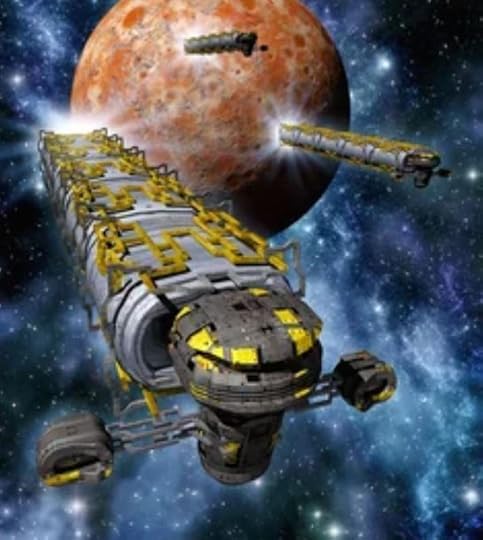
Depot ships are military transports, designed to have the armor to survive being targeted by enemy raids, and the cargo capacity to bring resupply to much bigger ships. They lack any Primaries or Secondaries, and have just enough defensive weapons and missile lanchers to keep pirates at bay. A ship that makes runs to and from locations is generally a “depot ship,” while one that travels with a fleet to resupply as needed is a field tender.
Frigate [Size Class 3] (FF)
A frigate is a ship smaller than a cruiser, but able to operate independently for long periods of time. Frigates don’t generally have Primaries, with Secondaries being their heaviest armament, but may have a great deal more defensive weapons and a decent bank of missiles. They are also designed to operate independently for long periods of time, and are often scouts, flank guards, exploration vessels, and the largest ship the richest and most powerful non-government groups can afford to build or maintain.
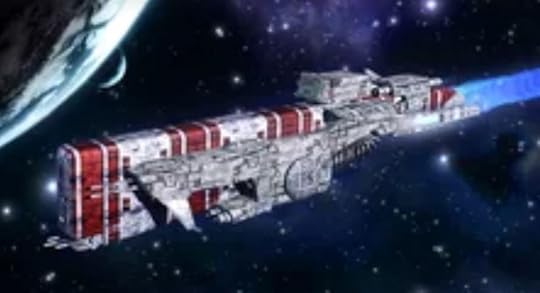
Early in the Gate Wars, it was determined that the ability of frigates to travel through self-generated Free Gates made them excellent scouts, raiders, and picket ships. Frigates were able to operate independently for long periods of time, allowing them to both strike deep into enemy territory, and sit on-station in defensive positions for long periods.
The original ships of this class were the largest vessels the first generation of Free Gates could move, and so these ships were build for mobile military operations and exploration. It was perhaps inevitable that the first starships able to generate their own warp gates, known as “Free Gate” ships, would come to be referred to as frigates. Since that function can now be filled by larger vessels, many modern frigates serve specialized functions, such as medical frigates (FFM), repair frigates (FFR), minelayer frigates (FFL), and diplomatic service frigates (FFD).
Patrol Carrier [Size Class 3] (CP)
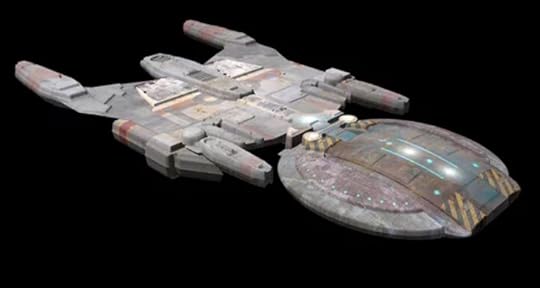
A patrol carrier is a warship roughly the size of a destroyer or frigate, that serves as a very small but self-reliant fighter carrier. These are most often used by high-tier navies as patrol craft for Gate Fords, allowing them to cover a large volume of space with numerous non-FTL craft the carrier can support and transport as needed. They can double as escorts for larger craft that lack enough hangar capacity for fleet operations.
Destroyer [Size Class 3] (DD) – Once the Gate Wars were in full swing, analysis revealed frigates which had not been designed primarily for combat missions, and simply too expensive and resource-intensive to build in large numbers to fill out fleets once all sides moved to wartime production priorities.
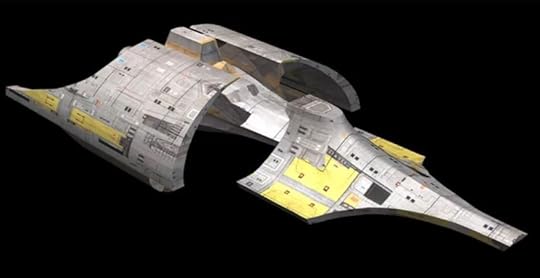
Instead, significantly smaller, much leaner ships initially conceived of as “Frigate-Destroyers” were designed. Frigate-destroyers could perform many of the wartime functions of a frigate, though with less self-sufficiency and shorter operating times. They lacked many of the capabilities that made frigates so flexible; such as small craft bays, landing craft for companies of marines, extended sensor arrays, deep storage and reloads, creature comforts for their crews, full self-repair systems, and facilities for diplomatic missions, disaster relief, and spare cargo capacity, but had just as much armor and first-strike armament as the vessel they were designed to counter. By stripping down to the bare military minimum, it was possible to build and crew two frigate-destroyers for the time and cost it would have taken to create a new frigate.
Frigate-destroyers proved extremely effective in their roles, and soon variants began to be built to perform specific missions. The term “destroyer” came to encompass a broad class of small long-endurance combat-focused starships. Destroyer escorts focused on defensive systems to help protect larger and more expensive starships, destroyer scouts had upgraded sensor systems, assault destroyers had higher first-salvo throw weights, and
Corvette [Size Class 4] (CV)
A corvette is the smallest vessel able to mount military-grade weapons, shields, and armor and power them at the same time as a mobile Gate. They are often used for reconnaissance, patrol duties, and interdiction operations. Corvettes are fast and maneuverable, allowing them to swiftly navigate through space and engage smaller targets. They usually carry point defense weapons and light missile systems.
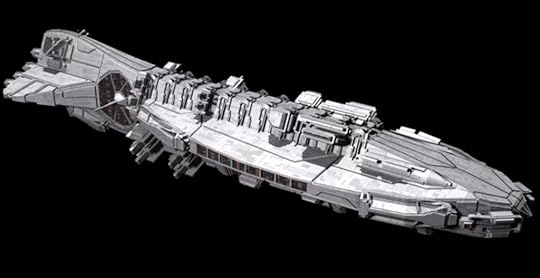
There also exist Slow Corvettes, which have slightly more weapons and secondary systems in return for not being able to power their Gate at the same time as other major systems. It takes weeks for a Slow Corvette to make a Gate jump anywhere, but that’s significantly better than being stuck somewhere forever. Slow Corvettes are popular escort ships in mid- and low-tier navies, designed to be carried by the Gate of the larger ship it’s escorting under normal circumstances, but able to travel solo in an emergency.
Brigantine [Size Class 4] (BG)
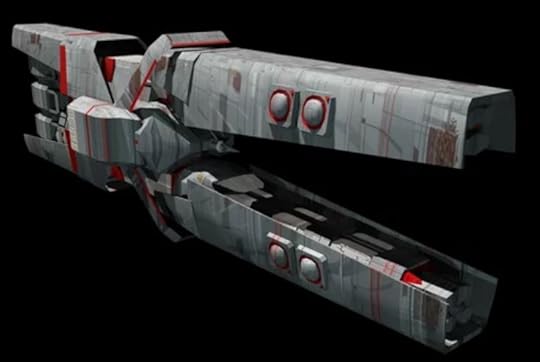
A brigantine is essentially a corvette that sacrifices having its own Gate for more weapons, armor, and secondary systems. They are common police and local defense vessels in relatively safe systems, and few can sometimes be carrier by the largest fleet carriers.
Pinnace [Size Class 5] (PN)
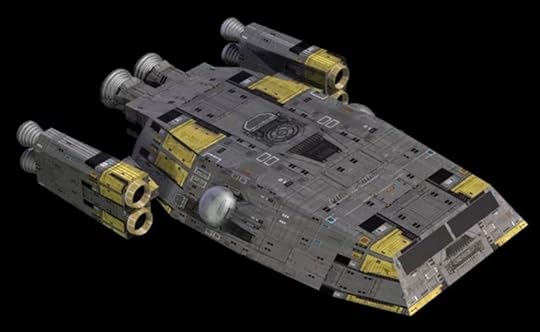
A pinnace is the smallest class of ship that can mount its own free Gate, and it can’t also fit in military-grade weapons. A pinnace can carry minor defensive weapons, and may be able to damage a pirate ship converted from a cargo ship or scout, but aren’t a match in a fight with any true military starship. They are often used as long-range transport ships carried by much larger ships, and as the private starships of the mega-rich.
Gunboat [Size Class 5] (GN)
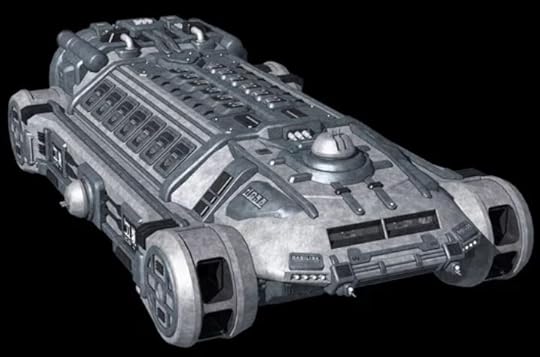
A gunboat is the smallest class of ship that can mount its own military-grade weapons (sometimes a single Secondary, usually just a few missiles and defensive weapons), but it can’t also fit in a free Gate. They are often squad leaders for attack craft in carriers and stations.
Cancer Support
I have cancer, and am on chemo (and likely will be for months to come). If you want to help me cover cancer treatment costs, right now, one great way to offer your support is to pick up The Traveler’s Guide to the Darklands: For Pathfinder 2E, which a vast number of amazingly talented people put together as a charity product to aid me. And it’s got excepts from Alphonse Lord Tabbington! Also, the product Like A Boss – A Book of Boss Encounters is a community project put together by Samurai Sheepdog to help me cover costs.
Or, if you prefer, I do accept donations to my Ko-Fi, which doesn’t take a cut before passing the money on to me. (Also, there are cat pics there!)
And, of course, a big part of my income comes from people supporting my Patreon, so joining that is a big help!
Owen K.C. Stephens's Blog
- Owen K.C. Stephens's profile
- 7 followers



